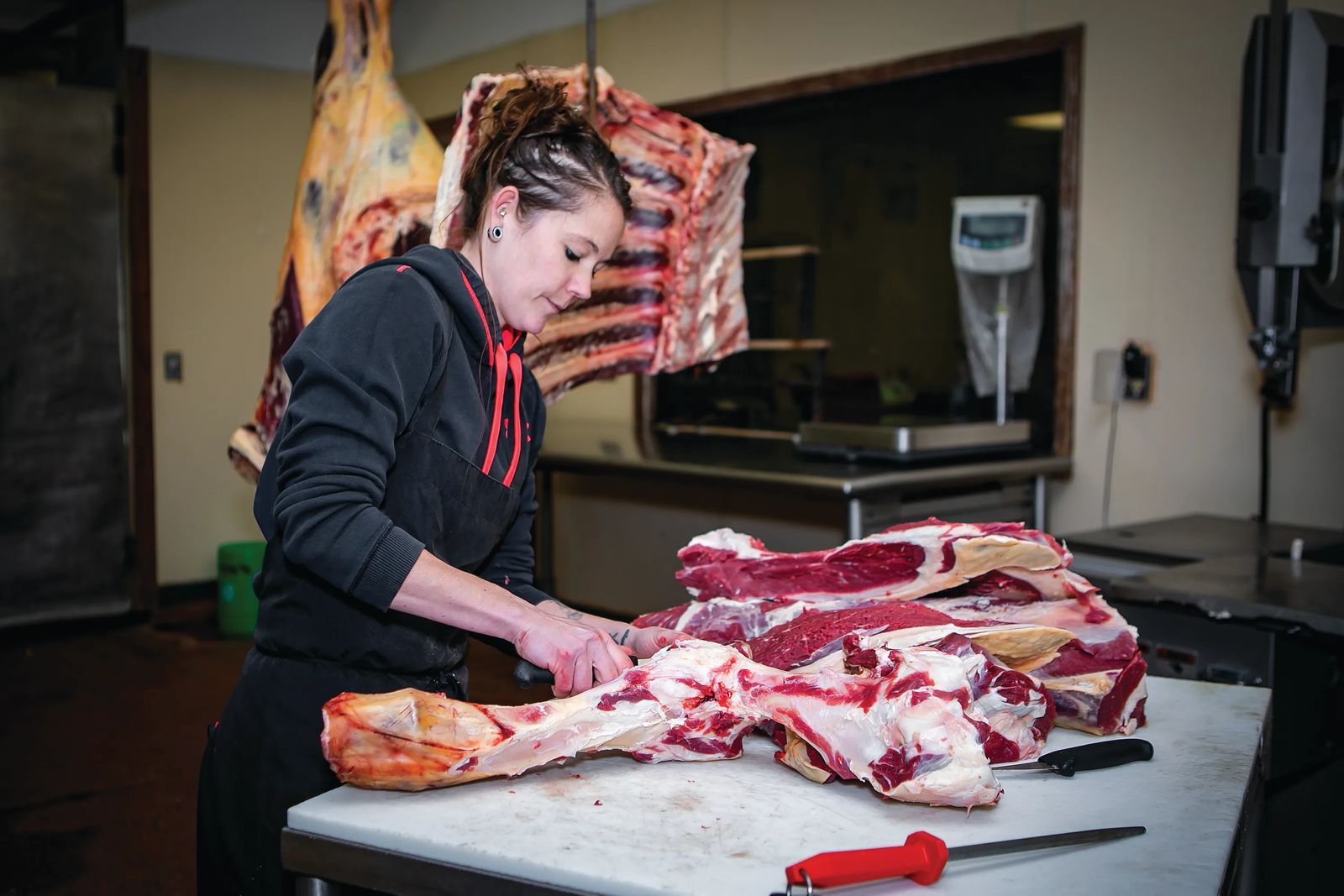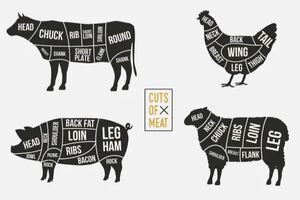
The Art of Butchering
January 1, 2020 | by anna rogers | photos by lovely hitchcock
Montana is a place steeped in a rich history of meat. From cattle ranches to an abundance of wild game, meat has become an integral part of the Montanan lifestyle. Ranching and hunting are timeless skills – true craftsmanship passed down from generation to generation. Butchering is no different.
The butcher is the “to” in farm-to-table or field-to-table – the link between the producer and the consumer. Without skilled butchering, the meat wouldn’t make it to the table, certainly not in the pristine cuts we’ve all come to know and love (and expect).
Thankfully, the art of butchering is not lost in Billings. There are plenty of joints in town to meet your meaty needs, each with their own unique style and passions, but all with the same goal: bringing better meat to your table.
Taste
Taste is what drives the entire process, from the animal’s birth and growth to its slaughtering and butchering. To miss this connection is to miss the heart of what it means to eat good meat. Everything from what the animal eats to how much fear it feels when being killed plays a role in the taste of the meat on your plate.
The best butchers know this, and in Billings, careful sourcing of meat is at the core of the art of butchering. “People who don’t care about their animals don’t raise good meat,” says Courtney Lane of 4th Avenue Meat Market. She and owner, Kevin Harrell, have noticed that when they go out with their truck for custom mobile slaughters, it’s always the folks who have a name for their animal and say goodbye whose meat cuts and tastes the best.
For Poly Food Basket, a small grocery shop in the center of residential Billings, sourcing the best meat with the best taste is what has differentiated their market. In 2003, Mike Christianson, a seasoned butcher for 50 years now, started to bring in and sell the best quality meat they could get. The store is now a community fixture and go-to for quality meat in town.
Texture
Fat has certainly been demonized in today’s culture, leaving people feeling that the only way to maintain a healthy diet is to eat lean meat. But fats from animals and vegetables provide the body with many beneficial nutrients essential in carrying out necessary functions in our bodies, like providing energy and supporting cell growth. When raised well, animals’ fat is an excellent source of nutrients and a key indicator of how good meat will taste.
When evaluating red meat, butchers look for well-marbled meat. Marbling is added fat between the muscle, not just fat you can cut off of the edge. Because it is intramuscular, it really impacts the juiciness and flavor of the meat.
Gary Pollack, the owner of Meat and Poultry Palace, advises, "When shopping for meat, always look for marbling. If you want prime rib or a nice steak, don’t pick out the leanest one.”
Time
Two elements of time play into excellent butchering. The first is the amount of time that passes from processing the meat to getting it into the consumers' hands (freshness), and the second is the amount of time the butcher allows for processes like aging, curing, and smoking.
At Meal and Poultry Palace, any ground beef purchased by patrons was ground within an hour or so. In addition, they make over 24 different flavors of sausage that are made right in house. This is freshness that you just can’t find at a conventional grocery store.
At 4th Avenue Meat Market, Kevin Harrell says he’s from an older school of thought as far as how he runs the business. “We’re not about “get ‘em in and get ‘em out” as fast as possible. We like to take our time and do the job to the best of our ability. We like to let time work for us. When aging a carcass, we let time do its job. When curing, the salt takes time to work its magic.”
Continuing the Trade
“Butchering is a trade, and I believe a lot of trades are disappearing arts,” says Harrell. “The art of butchering is something you can teach, and they can be self-sufficient, not having to rely on someone else to feed themselves. It’s hard work that's gratifying.”
In a place and culture that is so deeply rooted in the raising of livestock and the hunting of wild game, skilled butchers seem to be the perfect, necessary link between the animal and the plate.
The butchers’ know-how guides the consumer. “We are here to help you get the cut that you really need," says Pollack. "Often, we can suggest a different cut of meat that will work just as well and, most of the time, save you money.” Utilize Billings’ skilled butchers to guide your meat-buying and discover new cuts that are packed with potential.
Beyond guiding the selection of meat for cooking and eating, butchers have incredible insights into the animal with which they’re working. When working with animals that people bring in to 4th Avenue Meat Market, Harrell and Lane say it’s a challenge to educate the customer on what you can really get out of an animal. “Every animal is different. The yield depends on how old the animal is, the condition of the muscle, any old injuries inside, etc. You learn a lot about each animal when you cut into it.”
Connecting the Community
The work of butchers is connecting us all daily. We come together as families and friends to break bread (and cut meat) and spend time with one another. Montanans ranch together, hunt together, and enjoy the fruits of their labors through the work of skilled butchers. A freezer full of good meat feeds our families.
Beyond the tables of our own homes, meat in Billings has another story to tell through the work of Veteran’s Meat Locker.
The Veteran's Meat Locker is a service that provides meat to veterans and their families in the area. This organization is made possible by generous hunters who donate their wild game and by processors like 4th Avenue Meat Market who give a large portion of the processing of the game at no charge. This organization is an incredible example of how meat can really connect a community.
Whole Animal Butchering
Whole animal butchery, or nose-to-tail butchery, is making a comeback in popularity nationwide. The process minimizes waste, using as much of the animal as possible. For Kevin Harrell and Courtney Lane at 4th Avenue Meat Market, this old-fashioned method is just common sense. “It’s our outlook that the purpose of being a butcher is that every animal out there – everything on the carcass – has a purpose,” Courtney says.
For consumers, it's easy to think that a cow is just steak and hamburger, and chickens are just boneless, skinless breasts. That just isn't the case. An animal is made up of more than just muscle – skin, organs, bones, and fat are all a part of what butchers receive to work their magic.
Working with and utilizing the whole animal requires skill, but it also provides transparency to the butchers to be able to see the quality of the meat clearly. Because of this, butchers can offer better quality meat to consumers, and in a greater variety of cuts. At 4th Avenue Meat Market, Kevin and Courtney offer more unique and difficult cuts of meat and even utilize the bones.
Thanks to our article contributors!
- 4th Avenue Meat Market: 117 N 25th Street
- Meat and Poultry Palace: 821 16th Street W
- Poly Food Basket: 2648 Poly Drive
- Veteran’s Meat Locker: www.facebook.com/vetmeatlocker
Originally printed in the January 2020 issue of Simply Local Magazine
Never miss an issue, check out SLM's digital editions here!





